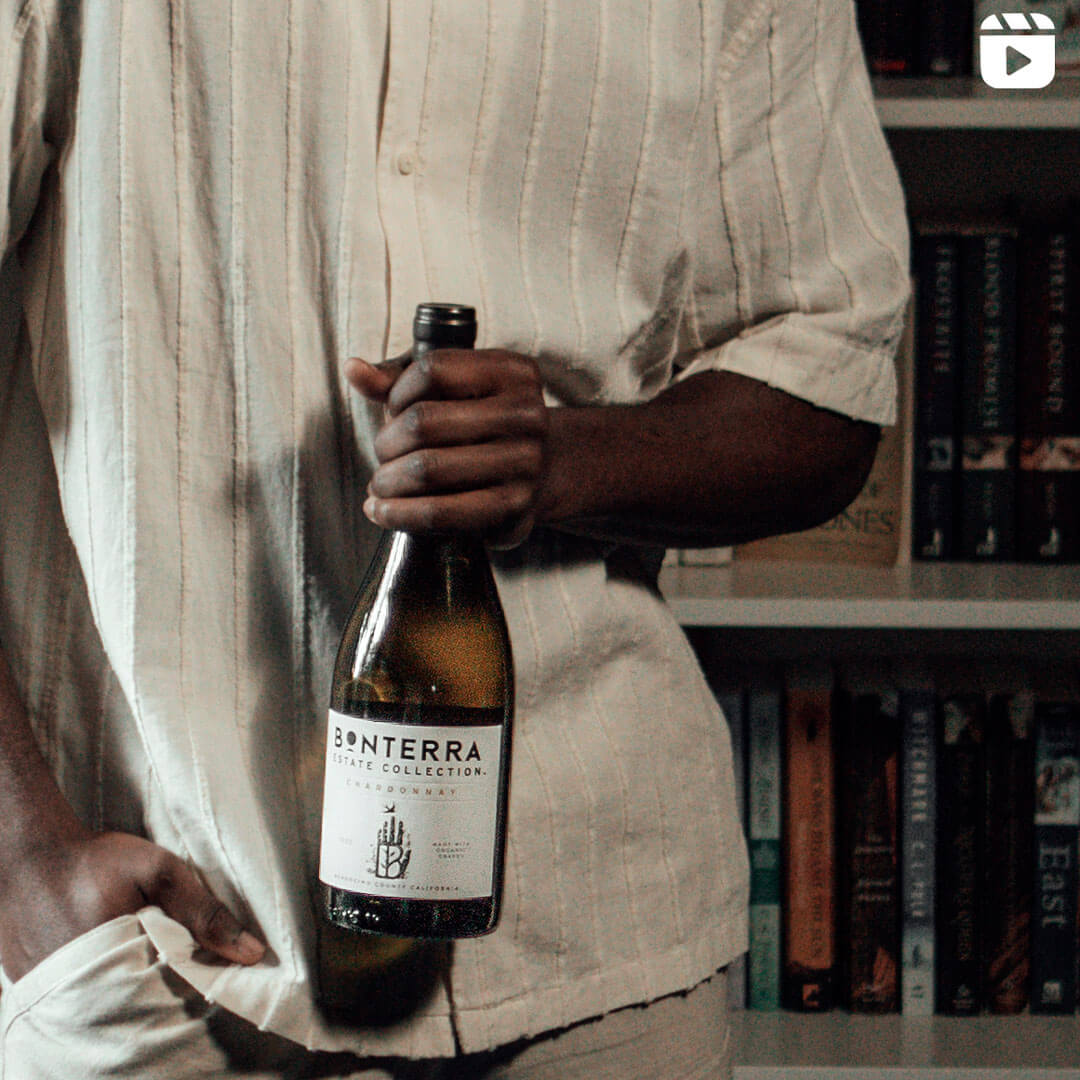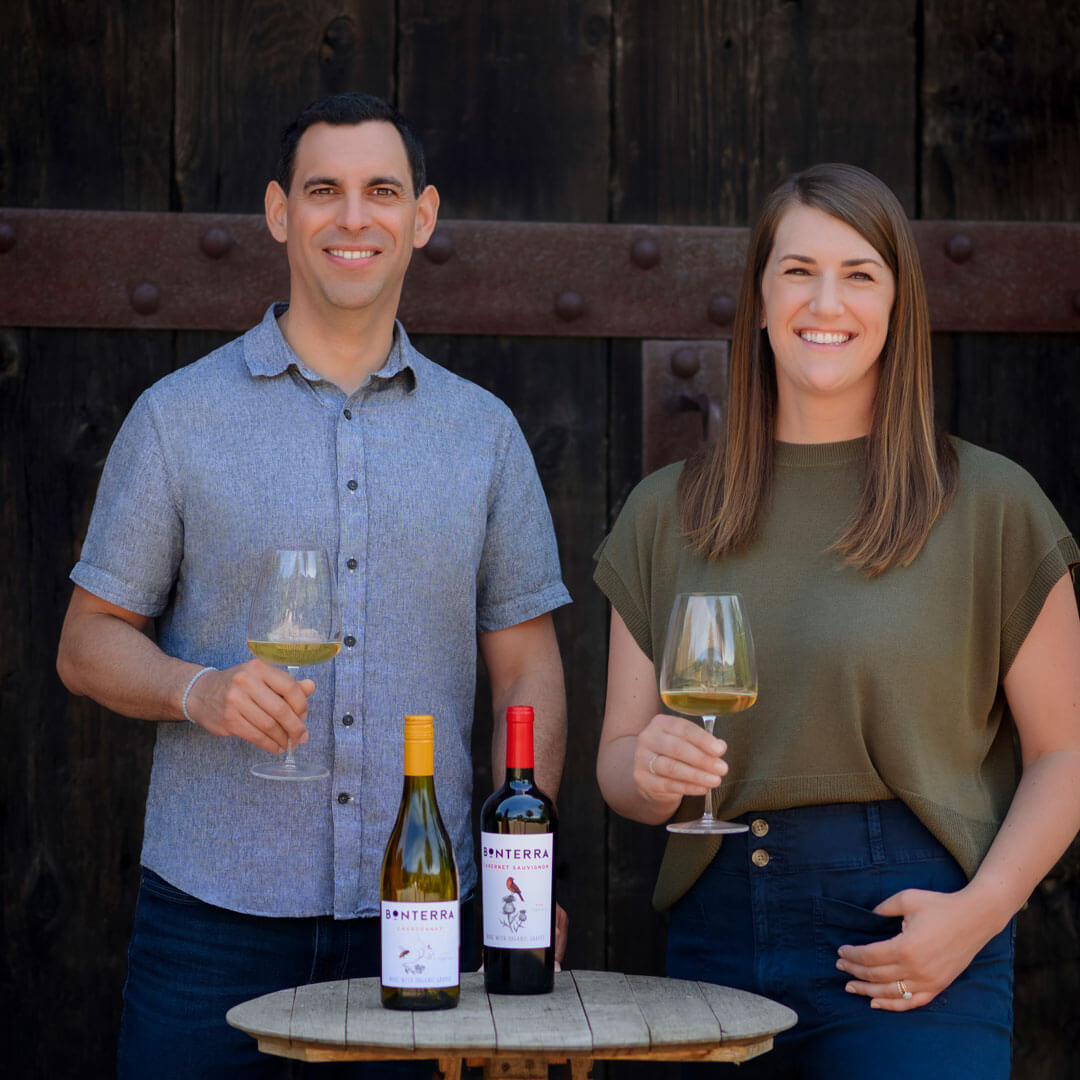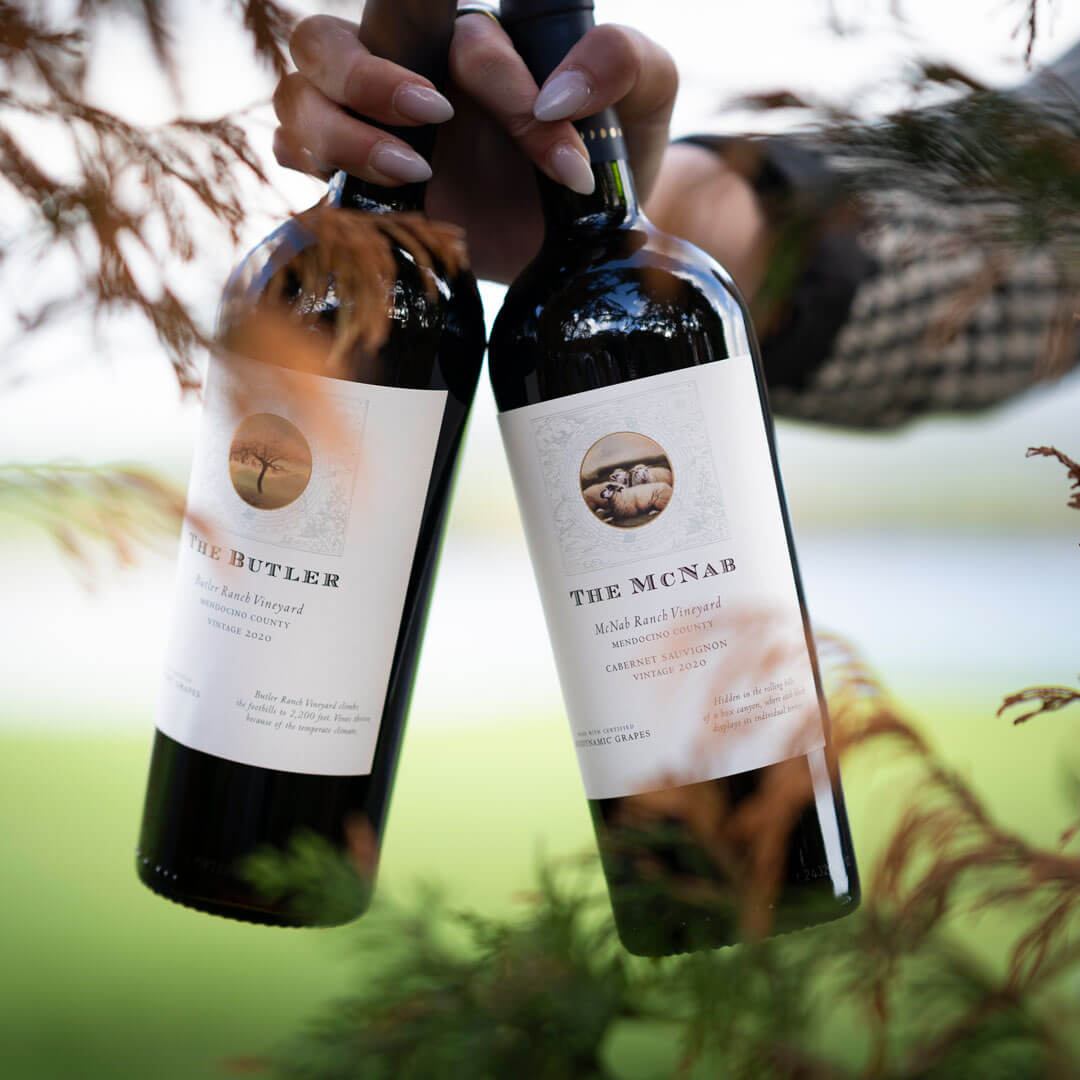When it comes to white wine, two varietals tend to lead the conversation: Chardonnay and Sauvignon Blanc. Both are wildly popular, endlessly versatile, and grown around the world—yet they couldn’t be more different in taste, texture, and personality.
At Bonterra, we craft both wines from organically farmed vineyards, letting nature shape their character. Whether you’re reaching for something crisp and citrusy or smooth and layered, understanding the difference between Chardonnay and Sauvignon Blanc can help you choose the best white wine for your taste—and your table. So let’s break it down. (Because while wine can be complex, choosing one shouldn’t be.)
The Essence of Chardonnay and Sauvignon Blanc
Before we get into what sets them apart, let’s start with what defines them. Each varietal brings its own signature style to the glass—one plush and layered, the other zesty and bright. There’s a reason you’ll spot both on wine lists everywhere: they’ve earned their place by being reliably delicious, yet endlessly expressive.
Chardonnay: The Chameleon of White Wine
Chardonnay stands as perhaps the most versatile white grape—a true chameleon capable of expressing itself in countless ways depending on terroir and winemaking choices. Our Bonterra Chardonnay wines embody this adaptability while maintaining its distinctive voice, mingling poached pear, spring melon, and subtle white floral notes.
What defines Chardonnay is its remarkable ability to reflect both its origin and its maker’s intention. Is Chardonnay dry or sweet? When grown in cooler climates, it presents with crisp acidity and flavors leaning to green apple, lemon, and mineral. In warmer regions like much of California, Chardonnay wines focus on richer profiles redolent of golden apple, stone fruits and even tropical notes.
The winemaker’s hand further shapes its expression—particularly through decisions about oak aging. Malolactic fermentation transforms sharp malic acid into softer lactic acid, creating that signature buttery mouthfeel in many Chardonnays. Oak imparts vanilla, toast, and spice notes, while stainless steel preserves bright fruit character and mineral precision.
Curious to explore a curated expression of this adaptable varietal? Try our organically farmed Chardonnay bundle—a collection that showcases Chardonnay’s rich personality and Bonterra’s organic approach.
Sauvignon Blanc: Vibrant and Expressive
Where Chardonnay reigns supreme for subtlety, Sauvignon Blanc announces itself with vibrant clarity. Its name derives from the French words “sauvage” (wild) and “blanc” (white)—an apt description for this grape’s personality that can’t entirely be tamed.
Our Bonterra Sauvignon Blanc captures the varietal’s hallmark characteristics: think zesty Kaffir lime, kiwi, citrus flower and herbaceous notes that embrace your palate with energetic acidity.
Sauvignon Blanc’s transparency of expression makes it particularly reflective of its terroir. From the gunflint minerality of France’s Loire Valley to the exotic passionfruit notes of New Zealand’s Marlborough region, to the elegant balance found versions from California, this grape isn’t hiding who it is—it always tells you exactly where it’s from.
Key Differences: A Side-by-Side Comparison
Now that we’ve set the stage for the Chardonnay vs. Sauvignon Blanc comparison, let’s break down what really separates these two popular white wines. From the wine body and acidity to flavor profiles and aging potential, here’s how Chardonnay and Sauvignon Blanc stack up—and how to decide which one best fits your next pour.
Body and Texture
Chardonnay: Medium- to full-bodied, with a texture that can range from crisp and linear to rich and creamy. Our Bonterra Chardonnay offers a sophisticated balance—substantial enough to satisfy those seeking richness, yet elegantly restrained enough to keep it versatile.
Sauvignon Blanc: Typically light- to medium-bodied, presenting a crisp, clean texture with vibrant acidity that delivers a refreshing mouthfeel. Our Sauvignon Blanc exhibits this classic bright character while offering just enough mid palate weight to support its expressive flavors.
The difference in body becomes particularly relevant when considering food pairings and seasonal drinking preferences. Chardonnay’s fuller body makes it the white wine of choice for cooler months and heartier dishes, while Sauvignon Blanc’s lighter profile shines during warmer weather and alongside lighter fare.
Flavor Profiles
Chardonnay: A spectrum ranging from citrus and green apple in cooler climates to ripe pear, yellow apple, and tropical notes in warmer regions. Oak aging introduces vanilla, butterscotch, hazelnut, and toast components. Our Bonterra Chardonnay beautifully walks this line, offering pineapple, cantaloupe, and apricot notes with a hint of white flowers and subtle oak integration.
Sauvignon Blanc: So, what is the signature Sauvignon Blanc taste? Characterized by pronounced citrus (often grapefruit or lime), green apple, grass, herbs, and sometimes tropical notes like passionfruit or kiwi. Our Sauvignon Blanc leads with bright citrus and kiwi, followed by a subtle herbaceousness that recalls our organic farming practices—where beneficial cover crops grow between vineyard rows.
These flavor differences aren’t just about grape genetics—they’re about place, process, and intention. At Bonterra, our organic, regenerative farming methods invite nature into the vineyard, enhancing each varietal’s purest expression. It’s a difference you can taste: Chardonnay and Sauvignon Blanc, grown with care, showing up as their most vibrant, nuanced selves.
Acidity and Structure
Chardonnay: Moderate acidity that provides structure without sharpness. With our Chardonnay, we seek balance—enough acidity to keep the wine fresh and food-friendly, but integrated in a way that allows other varietal elements to shine.
Sauvignon Blanc: High, vibrant acidity that creates a mouth-watering quality and contributes significantly to the wine’s refreshing character. Our Sauvignon Blanc embraces this natural zestiness, which serves as the backbone for its expressive fruit flavors.
This contrast in acidity shapes more than just taste—it defines the overall vibe of each wine. Chardonnay’s moderate acidity lends itself to a rounder, more layered profile (especially when oak-aged or stirred on the lees), while Sauvignon Blanc’s high acidity brings snap, freshness, and a lean, lively edge. It’s the difference between a glide and a zing—both compelling, depending on your mood and meal.
Aging Potential
Chardonnay: Known for its versatility and structure, Chardonnay—especially when oak-aged—can age gracefully for 5–10 years or more. With time, it sheds its primary fruit in favor of nutty, honeyed, and toasty complexity, offering a compelling reward for the patient collector.
Sauvignon Blanc: Typically at its best young, when its citrusy brightness and herbal lift are most pronounced. Most Sauvignon Blancs are meant to be enjoyed within 1–3 years of release. That said, select styles—like Sancerre from France’s Loire Valley, or Bordeaux Blanc, which is often made with oak or lees aging—can surprise with their longevity.
Whether you’re cellaring or sipping now, this is where intent matters. Chardonnay invites you to slow down and explore the arc of flavor over time; Sauvignon Blanc most often delivers its energy upfront, perfect for spontaneous moments that call for something crisp, clear, and instantly rewarding.
Winemaking Approaches: How Craft Shapes Character
Winemaking isn’t just about the grapes—it’s about the choices that shape them. From fermentation vessels to aging methods, every decision made in the cellar helps define the final wine in your glass. For Chardonnay and Sauvignon Blanc, those choices differ widely, resulting in two distinctive expressions shaped as much by craft as by climate.
Oak Treatment
Chardonnay: Often (though not always) aged in oak barrels, which impart flavors of vanilla, toast, and spice while allowing micro-oxygenation that softens the wine’s texture. Our Bonterra Chardonnay receives thoughtful oak aging that enhances complexity without overwhelming the fruit—a delicate balance we’ve refined over decades of organic winemaking.
Sauvignon Blanc: Typically aged in stainless steel to preserve its bright fruit character and zesty acidity. When oak is used, it’s often neutral or limited to a small percentage of the blend. Our Sauvignon Blanc follows this tradition, allowing the grape’s natural vitality to take center stage.
This fundamental difference in oak treatment creates two distinct styles that appeal to different palates and occasions—Chardonnay’s potential complexity and layers versus Sauvignon Blanc’s pure, direct expression.
Malolactic Fermentation
Chardonnay: Commonly sees malolactic fermentation (ML), a process that transforms naturally occurring tart malic acid into softer lactic acid. This can result in a richer, creamier texture and subtle buttery notes. But it’s not all or nothing—many winemakers, including Bonterra, take a more measured approach. Bonterra’s “The Roost” Single Vineyard Chardonnay, for instance, undergoes partial ML and is aged in a mix of new and neutral oak, and concrete, striking a refined balance between roundness and tension.
Sauvignon Blanc: Rarely undergoes malolactic fermentation, preserving its hallmark bright acidity and vibrant, zesty profile.
How—and whether—malolactic fermentation is used plays a major role in shaping a wine’s mouthfeel and overall expression. It’s one of many choices winemakers make when crafting distinctive styles.
Food Pairing: Enhancing the Culinary Experience
A wine’s personality often shines brightest at the table. Chardonnay and Sauvignon Blanc each bring something distinctive to the pairing game—whether it’s Chardonnay’s affinity for creamy pastas and roasted veggies, or Sauvignon Blanc’s knack for zinging up goat cheese and garden greens.
Chardonnay Pairings
Our Bonterra Chardonnay pairs brilliantly with:
- Cedar-plank salmon with herbs: The wine’s subtle tropical notes complement the smoky elements of this preparation.
- Fresh corn risotto: Toasty notes harmonize with richly sweet corn kernels, while balanced acidity cuts through the dish’s creaminess.
- Roasted chicken: The wine’s balanced profile enhances without overwhelming this classic pairing.
- Creamy pasta dishes: Chardonnay’s texture stands up beautifully to richer sauces.
- Aged cheeses: The wine’s complexity complements the depth of flavor in aged Gouda or Comté.
Sauvignon Blanc Pairings
Our Bonterra Sauvignon Blanc excels alongside:
- Fresh oysters with mignonette: The wine’s crisp acidity and mineral notes perfectly complement the briny freshness of oysters.
- Goat cheese salads: The wine’s tangy acidity balances the creamy richness of the cheese.
- Herb-forward dishes: The wine’s subtle herbaceousness enhances herb-driven cuisine.
- Thai or Vietnamese cuisine: Its brightness cuts through exotic spices and complements citrus notes.
- Grilled vegetables: The wine’s clean profile allows the natural flavors of summer produce to shine.
These pairing preferences reflect each wine’s fundamental nature—Chardonnay’s versatility and potential richness versus Sauvignon Blanc’s vibrant acidity and aromatic intensity.
Which White Wine Is Right for You?
After exploring what sets these two varietals apart, one question remains: which white belongs in your glass tonight? While both are standout choices, your ideal pour depends on what you’re craving—and what you’re pairing:
Consider Chardonnay If:
- You appreciate complexity and textural richness in your wines
- You’re serving poultry, creamy dishes, or heartier seafood
- The occasion calls for a wine with subtle layers that unfold gradually
- You enjoy nutty, toasty, or vanilla notes alongside fruit flavors
- You’re dining in cooler weather or a more formal setting
Consider Sauvignon Blanc If:
- You prefer vibrant, refreshing wines with pronounced acidity
- You’re serving lighter fare, particularly with herbs, citrus, or goat cheese
- The occasion calls for an immediately appealing, refreshing pour
- You enjoy herbaceous, grassy, or zesty citrus notes
- You’re dining in warmer weather or seeking a palate-cleansing aperitif
The Verdict?
Trust your palate—and the moment. Whether you’re in the mood for something creamy and layered (hello, Chardonnay) or bright and breezy (Sauvignon Blanc, we see you), there’s a Bonterra white that’s ready to rise to the occasion.
The Bonterra Approach: Organic Farming Expression
At Bonterra, our approach to both Chardonnay and Sauvignon Blanc is guided by a longstanding commitment to organic farming. We believe that when vineyards thrive in harmony with nature—when beneficial insects take the place of pesticides, cover crops enrich the soil, and biodiversity is prioritized—the grapes are better positioned to express their full potential.
While the connection between farming and flavor is nuanced, we find that this mindful approach helps preserve each varietal’s inherent character. Our Chardonnay shows freshness and balance that integrates beautifully with thoughtful oak aging. Our Sauvignon Blanc delivers vibrancy and clarity that echo the vitality of our vineyard ecosystem.Whether you’re drawn to the layered elegance of Chardonnay or the zesty lift of Sauvignon Blanc, choosing organic means embracing wines rooted in integrity—from the soil to the sip. Explore our organically farmed wine bundles for a curated tasting experience or try our premium white wine sampler to compare Chardonnay and Sauvignon Blanc side by side—each bottle crafted with care from certified organic vineyards.
Keep the learning going with our guides to food and wine pairing, tips on wine temperature, or a deeper dive through the Bonterra wine subscription.




